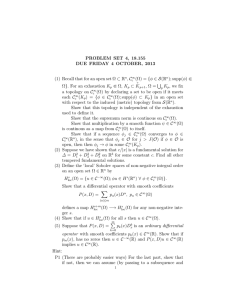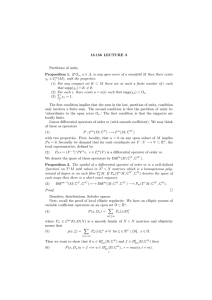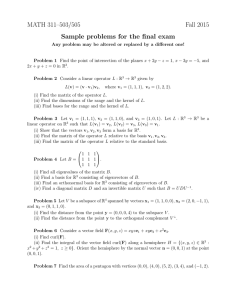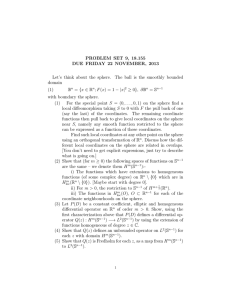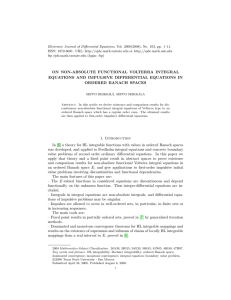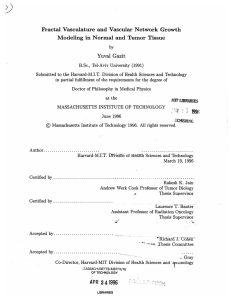18.155 LECTURE 15, 2015
advertisement
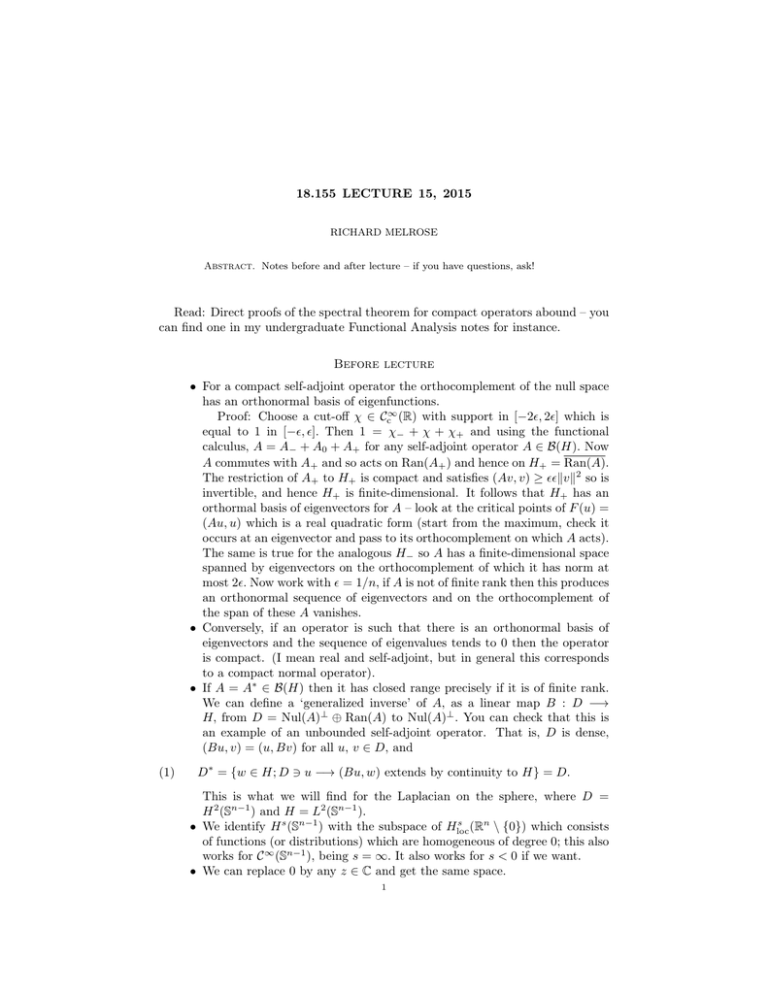
18.155 LECTURE 15, 2015
RICHARD MELROSE
Abstract. Notes before and after lecture – if you have questions, ask!
Read: Direct proofs of the spectral theorem for compact operators abound – you
can find one in my undergraduate Functional Analysis notes for instance.
Before lecture
• For a compact self-adjoint operator the orthocomplement of the null space
has an orthonormal basis of eigenfunctions.
Proof: Choose a cut-off χ ∈ Cc∞ (R) with support in [−2, 2] which is
equal to 1 in [−, ]. Then 1 = χ− + χ + χ+ and using the functional
calculus, A = A− + A0 + A+ for any self-adjoint operator A ∈ B(H). Now
A commutes with A+ and so acts on Ran(A+ ) and hence on H+ = Ran(A).
The restriction of A+ to H+ is compact and satisfies (Av, v) ≥ kvk2 so is
invertible, and hence H+ is finite-dimensional. It follows that H+ has an
orthormal basis of eigenvectors for A – look at the critical points of F (u) =
(Au, u) which is a real quadratic form (start from the maximum, check it
occurs at an eigenvector and pass to its orthocomplement on which A acts).
The same is true for the analogous H− so A has a finite-dimensional space
spanned by eigenvectors on the orthocomplement of which it has norm at
most 2. Now work with = 1/n, if A is not of finite rank then this produces
an orthonormal sequence of eigenvectors and on the orthocomplement of
the span of these A vanishes.
• Conversely, if an operator is such that there is an orthonormal basis of
eigenvectors and the sequence of eigenvalues tends to 0 then the operator
is compact. (I mean real and self-adjoint, but in general this corresponds
to a compact normal operator).
• If A = A∗ ∈ B(H) then it has closed range precisely if it is of finite rank.
We can define a ‘generalized inverse’ of A, as a linear map B : D −→
H, from D = Nul(A)⊥ ⊕ Ran(A) to Nul(A)⊥ . You can check that this is
an example of an unbounded self-adjoint operator. That is, D is dense,
(Bu, v) = (u, Bv) for all u, v ∈ D, and
(1)
D∗ = {w ∈ H; D 3 u −→ (Bu, w) extends by continuity to H} = D.
This is what we will find for the Laplacian on the sphere, where D =
H 2 (Sn−1 ) and H = L2 (Sn−1 ).
s
• We identify H s (Sn−1 ) with the subspace of Hloc
(Rn \ {0}) which consists
of functions (or distributions) which are homogeneous of degree 0; this also
works for C ∞ (Sn−1 ), being s = ∞. It also works for s < 0 if we want.
• We can replace 0 by any z ∈ C and get the same space.
1
2
RICHARD MELROSE
• Check that projective local coordinates identify H s (Sn−1 ) with functions
±
s
n−1
such that u = (Fj± )∗ u±
) for each j and sign.
j , uj ∈ Hloc (R
s
• The flat Laplacian is homogeneous of degree −2, and maps Hloc
(Rn \ {0})
s−2
n
to Hloc (R \ {0}) for each s, so if we define
2
∞ n−1
g
∆
)
S u = |x| (∆ũ), u ∈ C (S
(2)
then we get a map ∆S : H s (Sn−1 ) −→ H s−2 (Sn−1 ) for each s.
• This is a differential operator, in the sense that it is local and is a differential
operator in local coordinates.
• Suppose we consider uz = rz ũ where ũ ∈ C ∞ (Rn−1 \ {0}) is homogeneous
of degree 0. So uz is homogeneous of degree z and
∆rz ũ = rz−2 (−z(z + n − 2) + ∆)) ũ.
(3)
(4)
• Suppose 0 ≤ µ ∈ Cc∞ (Rn \ {0}) is of the form µ = ν(|x|) satisfies
Then define
Z
hu, vi = ũṽµdx, u, v ∈ L2 (Sn−1 ).
R
µ = 1.
As part of the homework for next week check that this is given by an integral
Z
h(Fj± )∗ u0 , (Fj± )∗ v 0 i =
u0 v 0 δdx0
Rn−1
0
0
L2c (Rn−1 )
whenever u , v ∈
depending on j and ±).
• If u, v ∈ C ∞ (Sn−1 ) then
for a fixed positive smooth function δ (not even
h∆S u, vi = hu, ∆S vi
is non-negative when u = v.
• Suppose u ∈ H s (Sn−1 ) is an eigenfunction of ∆S , so ∆S u = λu for some
λ ∈ C, then u ∈ C ∞ (Sn−1 ), λ = k(k + n − 2) for some k ∈ N0 and rk ũ is
an harmonic polynomial.
After lecture
I did the proof of (3) above in lecture; it and the symmetry of ∆S are based on
the formula
xi 0
f (|x|) in |x| > 0
∂xi f (|x|) =
|x|
for f ∈ C ∞ (0, ∞).
The proof of the last statement above uses
(1) Elliptic regularity for ∆Rn : If u ∈ H 2 (Sn−1 ) satisfies ∆S u = λu then its
homogeneous extension satisfies
2
|x|2 ∆Rn ũ = λũ, u ∈ Hloc
(Rn ).
2
This can be written ∆Rn ũ = |x|−2 ũ with the right side in Hloc
(Rn \ {0}),
4
n
so elliptic regularity shows that ũ ∈ Hloc (R \ {0}). Then the left side is in
4
Hloc
(Rn \{0}) and proceeding by induction it follows that ũ ∈ C ∞ (Rn \{0})
so u ∈ C ∞ (Sn−1 ).
From symmetry (∆S u, u) = (u, ∆S u) so λkuk2 = λ̄kuk2 and if u is nontrivial then λ ∈ R. I should have written out the proof that
(∆S u, u) ≥ 0
L15
(5)
3
which implies that λ ≥ 0. In fact this follows by the same sort of integration
by parts argument. Namely
Z
XZ
(∆S u, u) =
|x|2 ∆Rn ũũµ(|x|)dx =
|x|2 ∂xi ũ∂xi ũµ(|x|)dx ≥ 0
Rn
(6)
i
where the missing term is
Z
XZ
2
(∂xi |x| µ)(∂xi ũ)ũdx =
i
Rn
Rn
g(|x|)(x · ∂x ũ)ũdx = 0
Rn
by the homogeneity of ũ.
Now, once we know that λ ≥ 0 for an eigenvalue of ∆S we can see what
these eigenfunctions must be. Namely, if λ ≥ 0 then there is a solution of
z(z + n − 2) = λ with z ≥ 0,
r
n−2 2
n−2
n−2 2
n−2 2
) =λ+(
) , so z = −
+ λ+(
) .
(z +
2
2
2
2
Now consider |x|z ũ, for an eigenfunction with z above. From (3) it follows
that
∆Rn (|x|z ũ) = |x|z−2 (−z(z + n − 2) + λ)ũ = 0.
Since z ≥ 0, |x|z ũ is locally integrable across 0 and the equation (1) must
actually hold across 0, since the error would have to be homogeneous of
degree z −2 and supported at the origin (think more carefully about n = 2).
So in fact |x|z ũ must be a polynomial and so z = k is an integer and
λ = k(k + n − 2) is also an integer. Thus we have seen that the only
eigenfunctions of ∆S are the ‘spherical harmonics’ the restrictions to the
sphere of homogeneous harmonic polynomials.
Department of Mathematics, Massachusetts Institute of Technology
E-mail address: rbm@math.mit.edu
